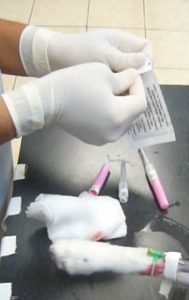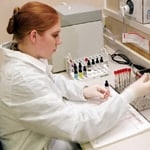Ron Hines DVM PhD

 Causes Of Most Abnormal Blood & Urine Tests
Causes Of Most Abnormal Blood & Urine Tests
 For a list of health problems that can delay blood clotting in your pet, go here
For a list of health problems that can delay blood clotting in your pet, go here
Your Dog And Cat’s Whole Blood Coagulation Time on Glass – One Of Many Ways To Measure How Long It Takes For Your Pet’s Blood To Clot
This test examines the same system as does Bleeding Time (Buccal Mucosal Bleeding Time or Toenail Bleeding Time); but instead of relying on clot formation activators released from injured tissue, the test relies on the negative charge of all glass surfaces to begin the clotting process (coagulation cascade). It measures how long it takes a sample of blood from your dog or cat to clot after it has been placed in a thin glass tube or on a glass slide.
The WBCT or CT test is not a sophisticated test. But it is an easy one for your veterinarian to perform in his office. A common reason is to check for clotting problems before surgery.
Complementary Tests That Come To Mind:
If your dog or cat’s blood fails the test, other more sophisticated tests, such as prothrombin time (PT), activated partial thromboplastin time (APTT), thrombin time, fibrinogen concentration, thrombocyte count, vWF, Blood Calcium or vitamin K level will be need to determine exactly why your dog or cat’s blood is slow to clot.
DxMe
You are on the Vetspace animal health website
Visiting the products that you see displayed on this website help pay the cost of keeping these articles on the Internet.


